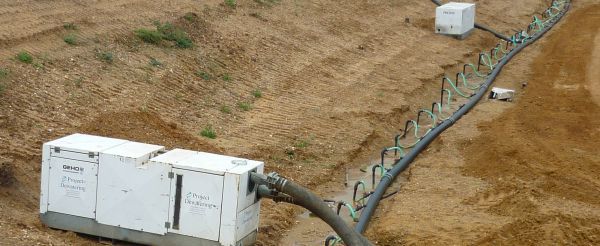What are Wellpoints?
A wellpoint is a small-diameter, closely-spaced shallow well, which offers a highly economic and versatile method of groundwater control where drawdown requirements onsite are less than 5-6 metres in depth. Wellpoints are pumped using a specialist surface vacuum pump and are particularly effective in stratified and fine-graded soils. Wellpoint dewatering also has the advantage of having a comparatively quick installation time, making it ideal for dynamic sites, where for example, pipeline installation may be required, and where many metres of pipe can be laid in a single shift.
Each wellpoint consists of a small diameter riser pipe (typically 38 to 50 mm), with a slotted filter at the base, and the wellpoint pump is connected to the header main pipe. The wellpoint pump creates a partial vacuum in the header main, which draws up the water so that it can be discharged at a designated point. Typically, wellpoints are installed around the perimeter of an excavation, or parallel to a pipeline trench, by either jetting, auguring or traditional drilling techniques.

As vacuum and flow is generated by a surface pump, limiting drawdown to 5-6m depth, a second stage of wellpoints can be installed at a lower level for greater depths.
Commonly, a wellpoint is regarded as ‘disposable’, but a steel self-jetted wellpoint can often be retrieved after the pump is turned off.
Project Dewatering offers a wide variety of wellpoint installation methods, providing clients with significant advantages:
- Wellpoints can be installed quickly in most ground conditions
- They are easy to maintain
- They can be used for both large and small-scale projects
- Steel self-jetting wellpoints can also be deployed, which are both re-usable and advantageous in environments with limited headroom
- Wellpoints can be installed within tunnels and cross-passages to depressurise confined layers encountered during construction
- Where difficult ground conditions exist, such as open gravel or overlying firm clays, wellpoints can be installed using a small rotary drilling rig, with either temporary casing, or traditional and hollow-stem augers.
By adopting the most appropriate installation methodology for the specific onsite ground conditions at hand, we can ensure optimal installation times for our clients.

